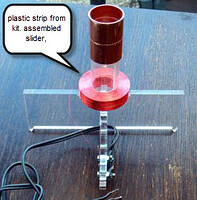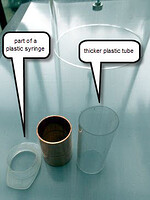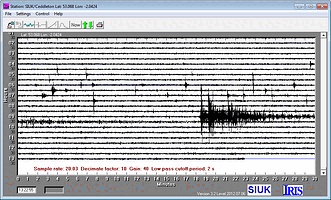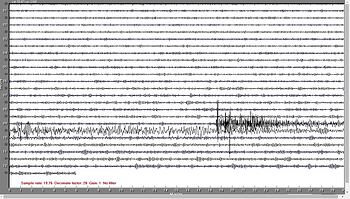In my search for an inexpensive seismometer I stumbled across radio’s that supposedly detect P waves and give early alerts to possible earthquakes. From what I can find, they seem popular in Japan and other countries that have frequent earthquakes. But I have found very little feedback on any consumer devices that use this technology. So I am looking for information on how these radio’s work, how well they work, and any technical details on how they are built. I could buy one off Amazon but they are pricey…so wondering what, if anything, about them makes them worth the big bucks, ie. some high tech device in them…
Maybe this wiki article about the Japan’s P-wave based early warning system will help? The only radio receivers mentioned in there are ones that receive a specially coded signal broadcast when the seismograph network detects P-waves. More about P-waves here but no indication that they can be detected other than by a seismograph ![]()
It is very difficult to find information on this topic. Of the consumer products I’ve found, one appears to detect sound waves generated by an earthquake, and the other says it detects changes in the magnetic field. Even though they mention P-waves in the advertisement they tend to mislead the reader into thinking that’s what these detect. Perhaps what they really do is intercept a signal from an actual seismometer site that “announces” the detection of P-waves.
Here is one semi-affordable device: http://www.infiltec.com/seismo/inf-qm45.htm
I also stumbled across another company that builds a device that detects earthquakes and is designed to shutdown critical devices. They mention elevators and trains. Apparently California now requires these devices in certain businesses.
Here is one example: http://www.amazon.com/DATAKOM-Earthquake-Shutdown-Detector-activity/dp/B00820ONIU
Here are a couple of consumer grade devices that I have no idea exactly what they “detect”:
http://www.amazon.com/Signstek-Earthquake-Earlier-Warning-Detector/dp/B00J2T6N9W
http://www.amazon.com/JDS-Earthquake-Alarm/dp/B001D8NMY4
The research continues…
Hi
I’ve been detecting earthquakes quite some time in the UK,Excellent very big earthquakes in Japan and the rest of the world
I’m using a rock wave instrument but unfortunately at the moment They do not have any available, I did speak to Mark and he says he was thinking about maybe sometime in the future a kit Seismic meter
The advantage of the rock wave instrument is very sensitive it will pick up earthquakes from around 4.5 Whereas some of the other instruments but only start to pick up about 6 magnitude but it does depend on your location, and where you’re trying to pick up signals from,
Here is one semi-affordable device: INFILTEC: Model QM-4.5LV Compact Seismomgraph Designed for School, Office, and Home Worldwide Earthquake Monitoring
I have not usually these instruments from www.infiltec.com the kit seems to be very easy to install you don’t have to mess around with Calibrating the hardware As it using a geophone sensor
The specifications say that it works similar to the AS1 seismometer { AS1 Hardware needs to be calibrated Occasionally ,This instrument works like a swinging gate, with a coil/magnet that picks up the movements
and then is sent to the amplifier and the signal is amplified and displayed in relevant software
Have a look at Seismometers | SAGE ,These are the ones that are mostly used in schools
I am thinking of getting a TC1 is a vertical seismometer , It looks easy to put together and it Uses a USB dongle Module
mick
I don’t think the infiltec is sensitive enough to justify spending that kind of money.
I second the TC1 (slinky) idea, I’m pretty sure I could build one for a lot less than the $350(?) kit price, but I would need to make a turn counting, coil winding fixture and it’s hard to justify that to use once.
I looked hard at the Infiltec QM-45 and arrived at the same conclusion. It’s not sensitive enough. I believe much of the cost of the TC1 is in the amplifier.
Not that I can see. There’s maybe $20 of components in the amp part, and the arduino uno is about $25. Building the amp will be a bit time consuming without having the printed circuit board but it’s a simple circuit with only one small chip (at least on the schematic I found) and “prototype boards” are available that plug into the arduino board. I think the cost probably represents the time involved in making the parts like the coil and the various mechanical bits.
I guess I have to ignore this thread this otherwise I’ll be forced to build one :lol:
The kit Hardware in the UK is about
That sounds good. Do you have a link to that
[quote author=niko link=topic=61436.msg491377#msg491377 date=1444412487]
That sounds good. Do you have a link to that
Thanks, I’ll check that out ![]()
Hi
Update
I’ve started to put the slinky seismometer together, the kit I purchase contains everything except the electronic amplifier, which I’m hoping to make myself using the Arduino plus project shield I will make a small circuit board to hold the amplifier components which then connect to the project shield, then this plugs into the Arduino board
Going through the components in the kit,The outer cylinder is made from two acrylic rings and a Thick polyurethane type plastic cylinder, which is folded up in the box
You open out the flat plastic tuber, and slide the two acrylic rings over it Which makes the cylinder, (It will do the job, but for my build I’ve replaced it with an acrylic Tube with a wall thickness of 3 mm)
I disregarded the polyurethane tube system
The coil is mounted on top of acrylic plastic stand which is very adequate, no alterations with this,
When assembling the magnets on the end of the screws. I decided to use Very small amount of poxy resin to secure them in the centre, This helps when centring the magnets in the coil
There is a small copper tube, Which you have to roll up a small plastic strip to put inside it .This makes a small tube positioned inside the copper fitting all this does is allow you to adjust the height, above the coil,
This plastic tube sits on top of the coil,
I find that the plastic strip is very thin ,And it can be difficult to keep in position on top of the coil When aligning the magnets dangling from the coil,
I have used some thicker plastic to make the tube that fits inside the copper fitting, and on the end of this tube. I have mounted the open end of a syringe to the bottom of this plastic
This makes the part more stable easy to put together and will not move when aligning the magnets
Willl post some images tomorrow
Can’t wait to start the amplifier circuit,
mick
Update
I’ve connected this slinky seismic meter to a USB adapter
Today picked up one large earthquake on the slinky and also on the Rockwave instrument please see images
Very pleased with the results from the slinky, and it also picks up local events, ![]()
Still working on the small circuit board amp that will connect to Arduino
Looks very good so far ![]() I think the extra signal processing of the amp+arduino should reduce those local events.
I think the extra signal processing of the amp+arduino should reduce those local events.
This topic was automatically closed 180 days after the last reply. New replies are no longer allowed.




